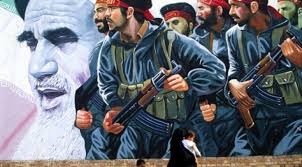| Online: | |
| Visits: | |
| Stories: |
Iran Revolution Guards Intelligence Organization
Monday, October 26, 2015 1:17
% of readers think this story is Fact. Add your two cents.
September 2015
Iranian supreme leader Ali Khamenei made a speech in his meeting with Revolutionary Guards commanders on September 16th focusing on threats his regime is facing after the nuclear agreement and the IRGC’s duty to confront these threats. Khamenei specifically emphasized on the duty of the IRGC intelligence in saying, “The IRGC intelligence must constantly follow up and identify threats.” What is the IRGC intelligence Khamenei was emphasizing on? Where does it stand in the hierarchy and structure of the Iranian regime? What is its own framework?
History of IRGC Intelligence Organization Foundation
In 2005, after unifying his regime with the presidency of Ahmadinejad, Khamenei had more than ever before intertwined his throne to the IRGC. In this regard to specify the threats and the strategy to maintain his rule, Khamenei issued an order on June 20th, 2005 for the foundation of the IRGC Center of Research & Strategy, and appointing of Brigadier General Mohammad Ali Jafari as the commander of the unit.
- The IRGC Center of Research & Strategy worked for two years and on September 3rd, 24th and 29th, 2007 specified the threats facing the Iranian regime, and Tehran’s strategy after the presidency of Mohammad Khatami inside the country, and the presence of US forces in Iraq after 9/11. This unit concluded that the main threat comes from inside the country and even foreign attacks are threatening due to the fact that they lead to uprisings inside the country. Jafari said internal dissent has reached a point that either it will lead to an uprising, or it can be provoked by a foreign attack.
“The IRGC strategy must change considering the upcoming conditions for the Islamic revolution. The main IRGC mission under the current status quo is to focus on missions carried out by the Bassij(paramilitary units). These missions are half of the IRGC’s missions, and therefore the necessities of these missions must be provided for,” Jafari said back in September 2008.
- The strategy presented by this center was focused on two pillars. The foreign enemy being the US, and the internal enemy being the Iranian people themselves. Since the balance of power doesn’t allow a direct war against the US, under the pretext of asymmetric war to confront and distance the threat posed by the US, the war against America was launched in lands occupied by US forces and by relying the people of those specific countries, (meddling in those countries by Iran). Inside the country the IRGC must also be prepared to confront any uprisings.
Following the presentation of these strategic results, Khamenei appointed Brig. Gen. Jafari as commander of the IRGC to form this corps based on the results of the strategic center.
- Jafari organized the Quds Force to confront foreign threats (meddle in countries abroad) as an offensive weapon. To fend off any possible military strike, Jafari restructured the missile and air force under the “aerospace” unit by strengthening Iran’s ballistic missiles. To quell and crackdown any possible uprising inside the country, Jafari divided the IRGC Ground Forces into 31 provincial corps in combination with the Bassij forces.
- Following the 2009 uprising, Jafari said in September of that year that the IRGC intelligence branch will be enhanced to the IRGC Intelligence Organization led by Mullah Hossein Taeb. (Prior to this Taeb was commander of the Bassij units.)
IRGC Intelligence Hierarchy
The IRGC Intelligence Organization has a command staff with ten different departments. The headquarters and each department has an office in every province and large cities. (The hierarchy is the same and the level of the commanders differ).
The ten departments are as follows:
1. Political Department: consisting of three administrations
- Parties
- College Students
- State Officials & Directors
2. Social Department: consisting of five administrations
- Crimes
- Religions
- Discrepancy
- Economy
- Ethnic Groups & Nationalities
3. Security Department: consisting of four administrations
- Military Intelligence Battalions
- Weapons
- Armed Opposition Groups
- VIP Security
4. Operations Department: consisting of three administrations
- Special Cells & Operations Teams
- Motor Teams
- Detention Centers
5. Technical Department
6. Material & Logistics Department: consisting of eight administrations
- Transportation
- Administrative & Financial Affairs
- Warehouses & Supplies
- Alimentary
- Arms
- Internal Weapons
- Physical Protection
- Barracks
7. Documents Center Department – consisting of two administrations
- Intelligence Archives
- Typists
8. Map Department
9. Collection Department – consisting of six administrations
- Phone 114
- Neighborhoods
- Administrative Offices
- Branches
- Secret Network
- Overt Cultural Network





